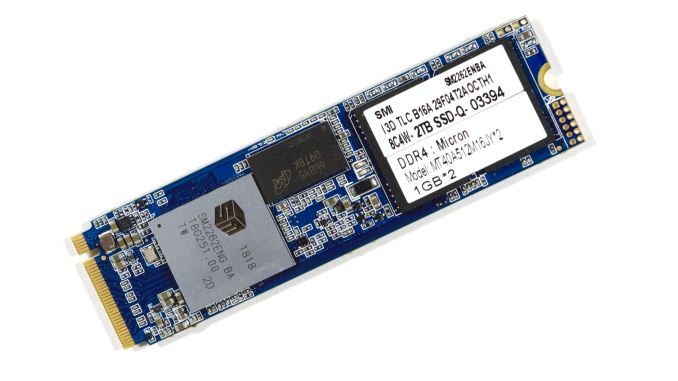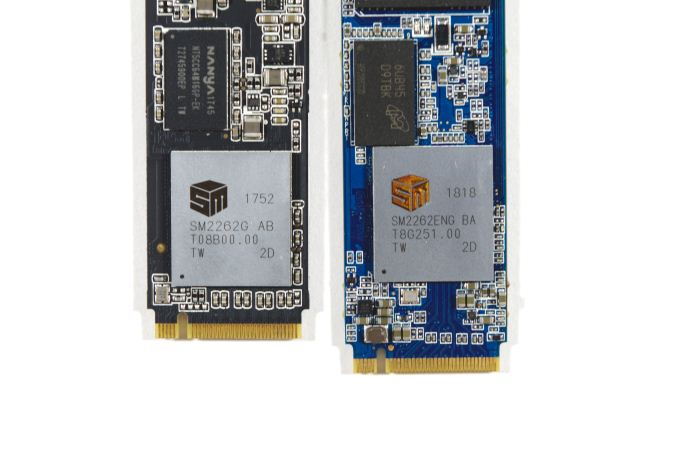The Silicon Motion SM2262EN SSD Controller Preview: Good And Bad Amplified
by Billy Tallis on August 1, 2018 11:45 AM EST
Silicon Motion's second-generation NVMe SSD controllers have all but taken over the consumer NVMe SSD market. Drives like the HP EX920 and ADATA SX8200 currently offer great performance at prices that are far lower than what Samsung and Western Digital are charging for their flagship products. These Silicon Motion-based SSDs are using the SM2262 controller - the high-end member of SMI's current lineup - but they're almost as cheap as the entry-level NVMe drives that use low-end controllers with limited performance. Phison's second-generation high-end E12 controller still hasn't hit the shelves, so Silicon Motion has no serious competition for the SM2262.
But Silicon Motion isn't standing still. They've prepared an update to the SM2262 controller called the SM2262EN. This was first previewed at the same time that the SM2262 was announced, but Silicon Motion didn't provide much guidance on the timing. The SM2262 controller hit the market with the Intel SSD 760p in January, and the SM2262EN is almost ready for release. With the SM2262EN, Silicon Motion is promising substantial performance improvements that go well beyond what we usually see from firmware optimizations, though the hardware changes relative to the SM2262 are minimal. The updated controller should hit the market in time to compete against Phison E12 SSDs and the first wave of drives with 96-layer 3D NAND.
| Silicon Motion NVMe SSD Controller Comparison | |||||
| Controller | SM2262EN | SM2262 | SM2263 | SM2263XT | SM2260 |
| Host Interface | PCIe 3.0 x4 | ||||
| Protocol | NVMe 1.3 | NVMe 1.2 | |||
| NAND Flash Channels | 8 | 8 | 4 | 4 | 8 |
| NAND Chip Enable lines | 4 | 4 | 4 | 4 | 4 |
| NAND interface speed | 800 MT/s | 667 MT/s | 533 MT/s | ||
| Typical NAND | IMFT 64L 3D TLC | IMFT 32L 3D MLC/TLC | |||
| DRAM Support | DDR3(L), LPDDR3, DDR4 |
No (HMB* supported) |
DDR3(L), LPDDR2 |
||
| DRAM Bus Width | 32/16-bit | 16-bit | N/A | 32/16-bit | |
| Controller Package | 18x16mm 472-ball TFBGA |
12x12mm 288-ball TFBGA |
18x16mm 472-ball TFBGA |
||
| Sequential Read MB/s | 3500 | 3200 | 2400 | 2400 | 2400 |
| Sequential Write MB/s | 3000 | 1900 | 1700 | 1700 | 1000 |
| Random Read IOPS | 420k | 370k | 300k | 280k (HMB*) 120k (no HMB*) |
120k |
| Random Write IOPS | 420k | 300k | 250k | 250k | 140k |
| *HMB = Host Memory Buffer - where an SSD uses system DRAM to save cost by not having any of its own | |||||
To assess the new SM2262EN controller solution, Silicon Motion has provided us with a 2TB reference design SSD with their latest firmware, a work in progress as Silicon Motion continues to optimize performance. This is a higher capacity drive than any of the SM2262 SSDs we've tested, and some performance improvement may be due simply to the capacity increase. However, even at 1TB we already have several NAND dies on each of the controller's 8 channels, so adding more dies shouldn't have a huge impact, especially not for sequential transfers.
| SM2262EN Engineering Sample Specifications | |
| Usable Capacity | 2000 GB |
| Controller | Silicon Motion SM2262EN |
| Firmware Version | SVN112 |
| NAND Flash | Intel 64-layer 256Gb 3D TLC |
| Form-Factor | double-sided M.2 2280 |
| Interface | PCIe 3 x4 |
| DRAM | 2GB Micron DDR4-2400 CL16 |

SM2262 (left) and SM2262EN (right)
This 2TB configuration represents the maximum practical capacity when using 256Gb NAND dies, as it requires four packages with stacks of sixteen dies. The usable capacity is configured as about 2000 GB. The PCB layout is generally the same as for the SM2262 drives we've seen, with one DRAM package and two NAND packages on each side. This drive uses 2GB of Micron DDR4 DRAM, while all of the SM2262 retail drives we've seen use DDR3L.
The switch to DDR4 gives a slight improvement to voltage and latency, and a big boost to throughput—which is probably necessary to make the most of the EN controller variant. The use of DDR4 does add slightly to the cost of the drive, but not enough to prevent this change from carrying over into retail products. The DRAM update still leaves Silicon Motion a bit behind Samsung, which has moved its SSDs to LPDDR4 and reaped significant power savings.
For this review, the 2TB SM2262EN drive is compared against other recent NVMe SSDs, primarily high-end drives. The results from our engineering sample of the upcoming Phison E12 controller are also included, and these two new controller solutions will probably be responsible for the stiffest competition in the NVMe SSD market segment once they are both shipping in volume.
| AnandTech 2018 Consumer SSD Testbed | |
| CPU | Intel Xeon E3 1240 v5 |
| Motherboard | ASRock Fatal1ty E3V5 Performance Gaming/OC |
| Chipset | Intel C232 |
| Memory | 4x 8GB G.SKILL Ripjaws DDR4-2400 CL15 |
| Graphics | AMD Radeon HD 5450, 1920x1200@60Hz |
| Software | Windows 10 x64, version 1709 |
| Linux kernel version 4.14, fio version 3.6 | |
| Spectre/Meltdown microcode and OS patches current as of May 2018 | |
- Thanks to Intel for the Xeon E3 1240 v5 CPU
- Thanks to ASRock for the E3V5 Performance Gaming/OC
- Thanks to G.SKILL for the Ripjaws DDR4-2400 RAM
- Thanks to Corsair for the RM750 power supply, Carbide 200R case, and Hydro H60 CPU cooler
- Thanks to Quarch for the XLC Programmable Power Module and accessories
- Thanks to StarTech for providing a RK2236BKF 22U rack cabinet.











28 Comments
View All Comments
Death666Angel - Thursday, August 2, 2018 - link
I don't read it that way, but okay. :) I don't have a definitve cost breakdown of an SSD. But my best guess is NAND is still the factor #1 and goes up with capacity. #2 would be the controller or the RAM, depending on size of the SSD, which usually correlates with the size of the RAM. But controllers can cost a few dollars or a few tens of dollars, so that is still a relevant number in pricing of an SSD. Samsung and WD price their drives that way. because they can, so far.FunBunny2 - Friday, August 3, 2018 - link
well, here's the problem. if you're an economist, then marginal cost is the driver of price in a competitive market. whether that's true for SSD/SSDparts is murky. for the accountant/MBA types, average cost drives price, regardless of market.now, the crunchy aspect of correlating cost to price is the production process. in the 19th century, labor was a significant component of cost and thus price. demand slackens, fire people to keep both costs more or less stable. demand increases, hire for the same effect.
in the 21st century, with SSD/SSDparts, there's virtually no labor in direct production, so marginal cost is near 0; ergo the econ types say to drop price to move more product. the accountant/MBA types recognize that most of average cost, while higher than marginal, is mostly amortization of R&D and capital equipment (all those new fabs AT has been reporting on, recall?). even they understand that the decision is the same as the econ, a very rare event: the only way to make money is to move more product and drive down average cost. but they can only do this is demand increases. and that can only happen if end-user product vendors can 1) more ways to use the parts, and 2) people have more money to buy the end-user product.
1) is largely a substitution exercise; i.e. a zero-sum game among end-user product vendors. there's no growth in aggregate demand for end-user product, thus none for SSD/SSDparts. nobody wins.
2) is a purely macro-economic phenomenon, and thus dependent on the 'middle class' having more moolah to spend on more bling. you can see where this is going? with right-wing governments driving income concentration, aggregate demand eventually collapses. this is exactly what created the Great Recession.
end-user product vendors can't directly move 2), all they can do is encourage their governments to spread the wealth so that aggregate demand can grow, and they can sell more product. on the whole, they haven't shown the smarts to see where their bread is buttered. as labor cost diminishes, just firing bodies gains you less and less until it gains you nothing. growth in highly capitalized production economies of the 21st century doesn't work as it did in the primitive 19th.
greggm2000 - Thursday, August 2, 2018 - link
What I'd really like to see are SSD tests done on an (user) encrypted drive. Would performance be equivalent to a fully filled drive? I imagine this would be a fairly common use case?Billy Tallis - Thursday, August 2, 2018 - link
Software encryption does technically leak information if it uses TRIM commands or otherwise signals to the drive what data is and isn't valid. It also imposes performance overhead from doing the encryption on the CPU . There aren't many reasons to justify using software full-drive encryption on a SSD when self-encrypting SSDs are so common (Samsung, Crucial MX, etc).Icehawk - Saturday, August 4, 2018 - link
Is Opal effected by this? What performance cost is there? We’ve got whopping laptop at woro with it enabled buy I’d like to push us in a more secure direction. Would probably help our PCI score too.Chaser - Sunday, August 5, 2018 - link
I wish someone would build a review site that includes SSDs that writes reviews based upon a an average PC gamer's performance perspective. I myself have tested the Evo 860, the 970 EVO, Optane 900, the XPG SX8200, and the Patriot Hellfire. Like many other revealing Youtube videos that compare these drives most often the Evo 860 is either faster at loading a game, the same or very slightly slower. While I understand that Anandtech has readers that are looking at higher usage scenarios, I'd venture to say MOST of their readers are in the former category.As it stands today with most similar sites we see chart after chart of benchmarks on multiple pages. We read about accolades on random and sequential performance. Some sites rank the drives from 1-10. But in the end, the user experience differences prove to be negligible for most users and a simple article like that probably would entice site visits to read through the hairsplitting benchmarks.
KAlmquist - Sunday, August 5, 2018 - link
I'll repeat something Billy Tallis stated in a comment and probably should incorporate into the text of the review: “I did run the Heavy and Light tests on this drive with it 80% full and the results were similar to the 100% full case.”When I partition an SSD, I've always left a bit of space unused in order to effectively increase the spare area to 20% or so. That improved performance consistency with older SSD designs. With the SM2262EN, it might still reduce write amplification, but not enough to substantially affect performance.
kensiko - Wednesday, January 9, 2019 - link
I'm hesitating between the AData XPG SX8200 (SM2262) and the pro one (SM2262EN), 50 CAD$ difference. Any opinion ?